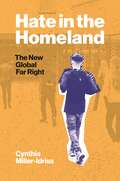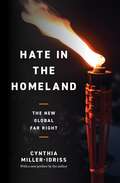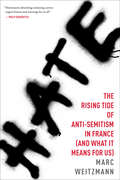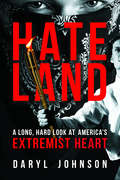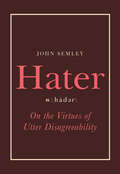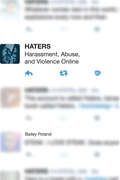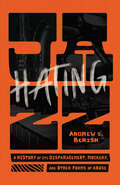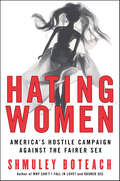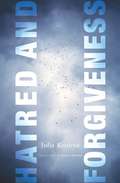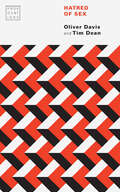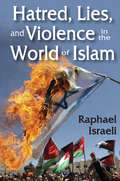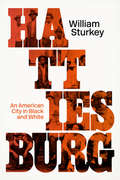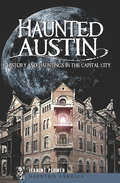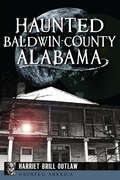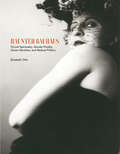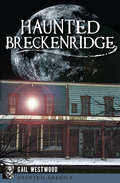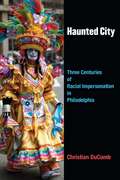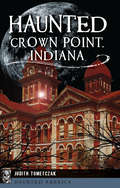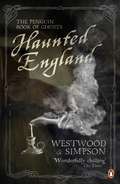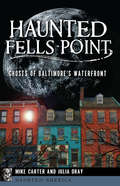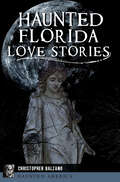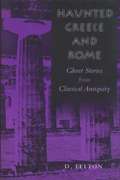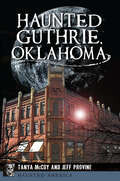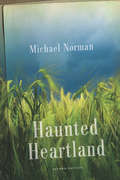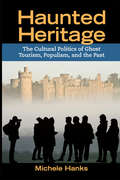- Table View
- List View
Hate in the Homeland: The New Global Far Right
by Cynthia Miller-IdrissA startling look at the unexpected places where violent hate groups recruit young people <P><P> Hate crimes. Misinformation and conspiracy theories. Foiled white-supremacist plots. The signs of growing far-right extremism are all around us, and communities across America and around the globe are struggling to understand how so many people are being radicalized and why they are increasingly attracted to violent movements. Hate in the Homeland shows how tomorrow's far-right nationalists are being recruited in surprising places, from college campuses and mixed martial arts gyms to clothing stores, online gaming chat rooms, and YouTube cooking channels. Instead of focusing on the how and why of far-right radicalization, Cynthia Miller-Idriss seeks answers in the physical and virtual spaces where hate is cultivated. Where does the far-right do its recruiting? When do young people encounter extremist messaging in their everyday lives? Miller-Idriss shows how far-right groups are swelling their ranks and developing their cultural, intellectual, and financial capacities in a variety of mainstream settings. She demonstrates how young people on the margins of our communities are targeted in these settings, and how the path to radicalization is a nuanced process of moving in and out of far-right scenes throughout adolescence and adulthood. Hate in the Homeland is essential for understanding the tactics and underlying ideas of modern far-right extremism. This eye-opening book takes readers into the mainstream places and spaces where today's far-right is engaging and ensnaring young people, and reveals innovative strategies we can use to combat extremist radicalization.
Hate in the Homeland: The New Global Far Right
by Cynthia Miller-IdrissA startling look at the unexpected places where violent hate groups recruit young peopleHate crimes. Misinformation and conspiracy theories. Foiled white-supremacist plots. The signs of growing far-right extremism are all around us, and communities across America and around the globe are struggling to understand how so many people are being radicalized and why they are increasingly attracted to violent movements. Hate in the Homeland shows how tomorrow's far-right nationalists are being recruited in surprising places, from college campuses and mixed martial arts gyms to clothing stores, online gaming chat rooms, and YouTube cooking channels.Instead of focusing on the how and why of far-right radicalization, Cynthia Miller-Idriss seeks answers in the physical and virtual spaces where hate is cultivated. Where does the far right do its recruiting? When do young people encounter extremist messaging in their everyday lives? Miller-Idriss shows how far-right groups are swelling their ranks and developing their cultural, intellectual, and financial capacities in a variety of mainstream settings. She demonstrates how young people on the margins of our communities are targeted in these settings, and how the path to radicalization is a nuanced process of moving in and out of far-right scenes throughout adolescence and adulthood.Hate in the Homeland is essential for understanding the tactics and underlying ideas of modern far-right extremism. This eye-opening book takes readers into the mainstream places and spaces where today's far right is engaging and ensnaring young people, and reveals innovative strategies we can use to combat extremist radicalization.
Hate: The Rising Tide of Anti-Semitism in France (and What It Means for Us)
by Marc Weitzmann“All those who care about France, Jews, East-West relations, and, indeed, our entire modern culture, must read this book.” —Tom Reiss, Pulitzer Prize–winning authorWhat is the connection between a rise in the number of random attacks against Jews on the streets of France and strategically planned terrorist acts targeting the French population at large? Before the attacks on Charlie Hebdo, the Bataclan night club, and others made international headlines, Marc Weitzmann had noticed a surge of seemingly random acts of violence against the Jews of France. His disturbing and eye-opening new book, Hate, proposes that both the small-scale and large-scale acts of violence have their roots in not one, but two very specific forms of populism: an extreme and violent ethos of hate spread among the Muslim post-colonial suburban developments on the one hand, and the deeply-rooted French ultra-conservatism of the far right. Weitzmann’s shrewd on-the-ground reporting is woven throughout with the history surrounding the legacies of the French Revolution, the Holocaust, and Gaulist “Arab-French policy.”Hate is a chilling and important account that shows how the rebirth of French Anti-Semitism relates to the new global terror wave, revealing France to be a veritable localized laboratory for a global phenomenon.“[An] excellent and chilling report-cum-memoir about one of the most unsettling phenomena in contemporary Europe.” —The Wall Street Journal“[Hate has] an often illuminating intensity as it grapples with an unresolved French and European quandary . . . Cleareyed.” —The New York Times Book Review “Weitzmann’s absorbing reckoning carries urgent lessons and warnings for us all.” —Philip Gourevitch, New York Times-bestselling author
Hateland: A Long, Hard Look at America's Extremist Heart
by Daryl JohnsonA former Department of Homeland Security analyst takes a long view on the domestic terrorism threat from radicalized individuals and hate groups of various ideologies.America is a land in which extremism no longer belongs to the country's shadowy fringes, but comfortably exists in the national mainstream. That is the alarming conclusion by intelligence analyst Daryl Johnson, an expert on domestic extremism with more than twenty-five years of experience tracking radicalized groups for the US government. In this book, Johnson dissects the rapidly expanding forms of American hatred and radicalization, including white nationalists, antigovernment militias, antifascists (Antifa), militant black nationalists, and extremist Islamic groups. The author develops a concise model that explains how extremists on both the far right and the far left use the same techniques to recruit and to radicalize individuals, turning them into violent offenders. He also examines the political forces that fuel this threat and have kept the US government from properly identifying and developing countermeasures to deal with it, including a disproportional emphasis on Islamic terrorism. Johnson concludes by recounting individual stories of deradicalization, each of which was the result of personal reevaluations of formerly held extremist convictions. He recommends more resources at the state and federal levels for combatting radical movements and urges greater communication and coordination between law enforcement agencies. This in-depth analysis of a growing menace that has taken America hostage throws a stark light on the darkest segments of American society and provides practical means for dealing with their violent threats.
Hater: On the Virtues of Utter Disagreeability
by John SemleyA timely manifesto urging us to think critically, form opinions, and then argue them with gusto.Hater begins from a simple premise: that it's good to hate things. Not people or groups or benign belief systems, but things. More to the point, it's good to hate the things everyone seems to like. Scan the click-baiting headlines of your favorite news or pop-culture website and you're likely to find that just about everything is, supposedly, "what we need right now." We are the victims of an unbridled, unearned optimism. And our world demands pessimism. It's vital to be contrarian--now, as they say, more than ever. Because ours is an age of calcified consensus. And we should all hate that. In this scathing and funny rebuke of the status quo, journalist John Semley illustrates that looking for and identifying nonsense isn't just a useful exercise for society, it's also a lot of fun. But Hater doesn't just skewer terrible TV shows and hit songs--at its core it shows us how to meaningfully talk about and engage with culture, and the world. Ultimately, Hater is what we actually need right now.
Haters: Harassment, Abuse, and Violence Online
by Bailey PolandCybersexism is rampant and can exact an astonishingly high cost. In some cases, the final result is suicide. Bullying, stalking, and trolling are just the beginning. Extreme examples such as GamerGate get publicized, but otherwise the online abuse of women is largely underreported. Haters combines a history of online sexism with suggestions for solutions. Using current events and the latest available research into cybersexism, Bailey Poland questions the motivations behind cybersexist activities and explores methods to reduce footprints of Internet misogyny, drawing parallels between online and offline abuse. By exploring the cases of Alyssa Funke, Rehtaeh Parsons, Audrie Pott, Zoe Quinn, Anita Sarkeesian, Brianna Wu, and others, and her personal experiences with sexism, Poland develops a compelling method of combating sexism online.
Hating Jazz: A History of Its Disparagement, Mockery, and Other Forms of Abuse
by Andrew S. BerishA deep dive into the meaning behind the hatred of jazz. A rock guitarist plays four notes in front of one thousand people, while a jazz guitarist plays one thousand notes in front of four people. You might laugh or groan at this jazz joke, but what is it about jazz that makes people want to disparage it in the first place? Andrew S. Berish’s Hating Jazz listens to the voices who have denounced, disparaged, and mocked the music. By focusing on the rejection of the music, Berish says, we see more holistically jazz’s complicated place in American cultural life. Jazz is a display of Black creativity and genius, an art form that is deeply embedded in African American life. Though the explicit racial tenor of jazz jokes has become muted over time, making fun of jazz, either in a lighthearted or aggressive way, is also an engagement with the place of Blackness in America. An individual’s taste in music may seem personal, but Berish’s analysis of jazz hatred demonstrates that musical preferences and trends are a social phenomenon. Criticism of jazz has become inextricable from the ways we understand race in America, past and present. In addition to this form of criticism, Berish also considers jazz hate as a form of taste discrimination and as a conflict over genre boundaries within different jazz cultures. Both enlightening and original, Hating Jazz shows that our response to music can be a social act, unique to our historical moment and cultural context—we react to music in certain ways because of who we are, where we are, and when we are.
Hating Women: America's Hostile Campaign Against the Fairer Sex
by Shmuley BoteachFrom the author of the internationally bestselling Kosher Sex. A wake-up call about the growing trend of misogyny in our culture-as evidenced by the flood of reality TV shows, ads, and lyrics that portray women as brainless bimbos, or worse Shmuley Boteach, the social commentator and outspoken relationship guru, shares his grave concerns about our society's growing contempt for women. Turn on the television: Reality TV shows such as The Bachelor, For Love or Money, and Average Joe boost their ratings by showing attractive women in competition for one man, one man's money, or both. On a "quest for true love," these women quickly devolve into a pit of vipers-and millions of Americans tune in each week for more. During commercial breaks, women are objectified to sell beer, cars, and every other product under the sun. Flip on the radio: Women are bitches, hos, and gold diggers, at least if you listen to the rap lyrics pumping out into our mass consciousness. And female pop stars like Britney and Madonna, says Boteach, have pushed the envelope past provocative and into the downright pornographic. 'Tween girls across the country follow their lead, and standards for how women should be treated plummet.Perhaps one of the most troubling aspects of this trend, he says, is women's complicity in their own degradation. Either they've become resigned to base stereotypes, or worse, they've bought into these mass market values (hence the deluge of shows like The Swan and Extreme Makeover, on which female contestants insist they need a new nose, teeth, or boobs to feel a positive sense of self-esteem). "There are strong consequences," writes Boteach, "in a world where men have no respect for women and women have no respect for themselves." Greedy gold diggers, brainless bimbos, publicity prostitutes, and backstabbing bitches-are these the stereotypes we want our sons and daughters bombarded by as they grow up? Hating Women offers a vision of how we can correct this downward spiral-along with a strong argument for why we absolutely must.
Hatred and Forgiveness (European Perspectives: A Series in Social Thought and Cultural Criticism)
by Julia KristevaJulia Kristeva refracts the impulse to hate (and our attempts to subvert, sublimate, and otherwise process it) through psychoanalysis and text, exploring worlds, women, religion, portraits, and the act of writing. Her inquiry spans themes, topics, and figures central to her writing, and her paths of discovery advance the theoretical innovations that are so characteristic of her thought.Kristeva rearticulates and extends her analysis of language, abjection, idealization, female sexuality, love, and forgiveness. She examines the "maladies of the soul," utilizing examples from her practice and the ailments of her patients, such as fatigue, irritability, and general malaise. She sources the Bible and texts by Marguerite Duras, St. Teresa of Avila, Roland Barthes, Simone de Beauvoir, and Georgia O'Keefe. Balancing political calamity and individual pathology, she addresses internal and external catastrophes and global and personal injuries, confronting the nature of depression, obliviousness, fear, and the agony of being and nothingness. Throughout Kristeva develops the notion that psychoanalysis is the key to serenity, with its processes of turning back, looking back, investigating the self, and refashioning psychical damage into something useful and beautiful. Constant questioning, Kristeva contends, is essential to achieving the coming to terms we all seek at the core of forgiveness.
Hatred of Sex (Provocations)
by Tim Dean Oliver DavisHatred of Sex links Jacques Rancière&’s political philosophy of the constitutive disorder of democracy with Jean Laplanche&’s identification of a fundamental perturbation at the heart of human sexuality. Sex is hated as well as desired, Oliver Davis and Tim Dean contend, because sexual intensity impedes coherent selfhood and undermines identity, rendering us all a little more deplorable than we might wish. Davis and Dean explore the consequences of this conflicted dynamic across a range of fields and institutions, including queer studies, attachment theory, the #MeToo movement, and &“traumatology,&” demonstrating how hatred of sex has been optimized and exploited by neoliberalism. Advancing strong claims about sex, pleasure, power, intersectionality, therapy, and governance, Davis and Dean shed new light on enduring questions of equality at a historical moment when democracy appears ever more precarious.
Hatred, Lies, and Violence in the World of Islam
by Raphael IsraeliHatred, Lies, and Violence in the World of Islam examines the torrential flood of anti-Israeli, anti-Jewish, and anti-Zionist propaganda that permeates many Muslim societies. Raphael Israeli locates the source of this anti-Semitic sentiment in the inadequacies and insecurities of Muslim states. By demonizing and delegitimizing Israel and Jews, they seek to eliminate a successful counterexample of their own failures, thus putting an end to their own "humiliation." Beyond mapping the distribution of anti-Israel and anti-Jewish propaganda in the Arab and Islamic worlds, Israeli uses case-studies to illustrate the premises of this study: the Palestinians, who have a direct stake in battling Israel; Turkey, which now claims leadership of the Arab and Sunni Muslim worlds; and Shi'ite Iran, which provides a more extreme example of both hatred and disregard for fact and history while threatening to destroy Israel. Israeli documents the worldwide collaboration between Jew-haters of all sorts, explaining the exponential growth of Jew-hatred on the Internet, with thousands of new hate sites added every year, outpacing Jew-hatred in the traditional media. He places anti-Semitism in a broader tradition of political lies and political deceit. In the final chapter, Israeli considers the possibility of reversing anti-Jewish agitation in Muslim countries, which he finds unlikely because so many of the region's regimes are built on foundations of anti-Semitism.
Hattiesburg: An American City in Black and White
by William SturkeyIn this rich multigenerational saga of race and family in Hattiesburg, Mississippi, William Sturkey reveals the personal stories behind the men and women who struggled to uphold their southern “way of life” against the threat of desegregation, and those who fought to tear it down in the name of justice and racial equality.
Haunted Austin: History and Hauntings in the Capital City (Haunted America)
by Jeanine PlumerDiscover the spirits and ghosts that have been keeping Austin weird for centuries in this guidebook to the city&’s supernatural residents. A killer lurks in the dark streets, victimizing servant girls throughout 1885, and Austin becomes the first American city to claim a serial killer. The spirits of convicts wander amidst the manicured grounds of the Texas State Capitol, while inside a public servant assassinated in 1903 still haunts its corridors. These are just a few of the strange and frightening tales of Haunted Austin. Within these pages lies evidence that the frontier bravado legendary in so many Texas men and women lives on long after death. Author Jeanine Plumer explores the sinister history of the city and attempts to answer the question: Why do so many ghosts linger in Austin?
Haunted Baldwin County, Alabama (Haunted America)
by Harriet Brill OutlawBaldwin County is no stranger to the supernatural. As the largest county in the state of Alabama, Baldwin has hidden stories to be uncovered. Residents can still hear the horse of a soldier buried in the Confederate Rest Cemetery. Lonesome melodies from a piano haunt the Grand Hotel Ballroom. Many residents have stolen a glimpse of Catman at Gulf State Park and a mysterious lady descending the stairs of a historic tidewater home. Author Harriet Outlaw tells the stories behind the spirits that represent the most colorful characters of Baldwin County history.
Haunted Bauhaus: Occult Spirituality, Gender Fluidity, Queer Identities, and Radical Politics
by Elizabeth OttoAn investigation of the irrational and the unconventional currents swirling behind the Bauhaus's signature sleek surfaces and austere structures.The Bauhaus (1919–1933) is widely regarded as the twentieth century's most influential art, architecture, and design school, celebrated as the archetypal movement of rational modernism and famous for bringing functional and elegant design to the masses. In Haunted Bauhaus, art historian Elizabeth Otto liberates Bauhaus history, uncovering a movement that is vastly more diverse and paradoxical than previously assumed. Otto traces the surprising trajectories of the school's engagement with occult spirituality, gender fluidity, queer identities, and radical politics. The Bauhaus, she shows us, is haunted by these untold stories.The Bauhaus is most often associated with a handful of famous artists, architects, and designers—notably Paul Klee, Walter Gropius, László Moholy-Nagy, and Marcel Breuer. Otto enlarges this narrow focus by reclaiming the historically marginalized lives and accomplishments of many of the more than 1,200 Bauhaus teachers and students (the so-called Bauhäusler), arguing that they are central to our understanding of this movement. Otto reveals Bauhaus members' spiritual experimentation, expressed in double-exposed &“spirit photographs&” and enacted in breathing exercises and nude gymnastics; their explorations of the dark sides of masculinity and emerging female identities; the &“queer hauntology&” of certain Bauhaus works; and the role of radical politics on both the left and the right—during the school's Communist period, when some of the Bauhäusler put their skills to work for the revolution, and, later, into the service of the Nazis.With Haunted Bauhaus, Otto not only expands our knowledge of a foundational movement of modern art, architecture, and design, she also provides the first sustained investigation of the irrational and the unconventional currents swirling behind the Bauhaus's signature sleek surfaces and austere structures. This is a fresh, wild ride through the Bauhaus you thought you knew.
Haunted Breckenridge (Haunted America)
by Gail WestwoodGhostly tales of Colorado&’s colorful—and chilling—past . . . photos included! From the old gold-mining towns of Summit County to skiing destinations in Breckenridge, eerie and true tales of life and loss in the Wild West abound in this corner of Colorado. The spirit of mutilated miner William Goodwin is said to haunt Blue River, warning of the dangers lurking below. Some say that the ghost of the widow Sylvia, who died destitute and alone at a boarding house on Main Street, still haunts the building today. Coldblooded killer Dr. Condon took revenge on his stalker and killed the town&’s favorite barkeeper. In this fascinating book, tour guide and author Gail Westwood explores the area&’s most haunted buildings and introduces the ghastly characters who seemingly never left.
Haunted City: Three Centuries of Racial Impersonation in Philadelphia
by Christian DucombHaunted City explores the history of racial impersonation in Philadelphia from the late eighteenth century through the present day. The book focuses on select historical moments, such as the advent of the minstrel show and the ban on blackface makeup in the Philadelphia Mummers Parade, when local performances of racial impersonation inflected regional, national, transnational, and global formations of race. Mummers have long worn blackface makeup during winter holiday celebrations in Europe and North America; in Philadelphia, mummers’ blackface persisted from the colonial period well into the twentieth century. The first annual Mummers Parade, a publicly sanctioned procession from the working-class neighborhoods of South Philadelphia to the city center, occurred in 1901. Despite a ban on blackface in the Mummers Parade after civil rights protests in 1963–64, other forms of racial and ethnic impersonation in the parade have continued to flourish unchecked. Haunted City combines detailed historical research with the author’s own experiences performing in the Mummers Parade to create a lively and richly illustrated narrative. Through its interdisciplinary approach, Haunted City addresses not only theater history and performance studies but also folklore, American studies, critical race theory, and art history. It also offers a fresh take on the historiography of the antebellum minstrel show.
Haunted Crown Point, Indiana (Haunted America)
by Judith TometczakFrom the jail cell that once held John Dillinger to quaint shops with dark beginnings, the restless spirits of Crown Point purportedly result from a century-old hex. Legend had it that a caravan of gypsies found themselves unfairly exiled from town. Forced to leave their beloved dead behind in unmarked graves, they invoked a venomous curse on the townspeople and vowed that no ancestor would be allowed eternal peace. Paranormal researcher Judith Tometczak exposes evidence of this deceptively quiet town's dark side.
Haunted England: The Penguin Book of Ghosts
by Jennifer WestwoodWatch out for a ghostly ship and its spectral crew off the coast of CornwallListen for the unearthly tread and rustling silk dress of Darlington's Lady JarrattShiver at the malevolent apparition of 50 Berkeley Square that no-one survives seeing Beware the black dog of Shap Fell: a sighting warns of fatal accidents England's past echoes with stories of unquiet spirits and hauntings, of headless highwaymen and grey ladies, indelible bloodstains and ghastly premonitions. Here, county by county, are the nation's most fascinating supernatural tales and bone-chilling legends: from a ghostly army marching across Cumbria to the vanishing hitchhiker of Bluebell Hill, from the gruesome Man-Monkey of Shropshire to the phantom congregation who gather for a 'Sermon of the Dead' ...
Haunted Fells Point: Ghosts of Baltimore’s Waterfront (Haunted America)
by Julia Dray Mike CarterThe narrow streets and ancient pubs of historic Fells Point are filled with the spirits of the past. Pirates, privateers, sailors, smugglers and a host of others refused to let death change their address. Walk with Edward Fell in the town he founded in 1760 or flirt with the “ladies” at the Cat’s Eye Pub. Climb the stairs at Bertha’s Mussels to visit the little girl with no face or let a long-dead nurse take your temperature at the Admiral Fell Inn. Ghost historians and authors Mike Carter and Julia Dray introduce the spiritual residents of Baltimore’s iconic waterfront neighborhood.
Haunted Florida Love Stories (Haunted America)
by Christopher BalzanoThe author and folklorist examines Florida&’s history through the lens of haunting tales of love. Wide eyes, sweaty palms and a racing heart. Are these the tell-tale marks of a love story or a haunted tale? If the story is set in Florida, there&’s a good chance it&’s both. From the infamous Bellamy Bridge to a haunted lighthouse in Key West, love is in the air—but it isn&’t always a good thing. Author and folklorist Christopher Balzano follows lingering campus whispers and trails that vanish into the swamp to track down the urban legends and ghostly lore of Sunshine State love affairs that live on even after death.
Haunted Greece And Rome: Ghost Stories from Classical Antiquity
by D. FeltonStories of ghostly spirits who return to this world to warn of danger, to prophesy, to take revenge, to request proper burial, or to comfort the living fascinated people in ancient times just as they do today. In this innovative, interdisciplinary study, the author combines a modern folkloric perspective with literary analysis of ghost stories from classical antiquity to shed new light on the stories' folk roots. The author begins by examining ancient Greek and Roman beliefs about death and the departed and the various kinds of ghost stories which arose from these beliefs. She then focuses on the longer stories of Plautus, Pliny, and Lucian, which concern haunted houses. Her analysis illuminates the oral and literary transmission and adaptation of folkloric motifs and the development of the ghost story as a literary form. In her concluding chapter, the author also traces the influence of ancient ghost stories on modern ghost story writers, a topic that will interest all readers and scholars of tales of hauntings.
Haunted Guthrie, Oklahoma (Haunted America)
by Jeff Provine Tanya MccoyA Victorian district frozen in time, Guthrie was the first territorial and state capital of Oklahoma, and many of its former residents still wander some of its majestic brick buildings. Outlaws and cultists haunt the infamous Black Jail, the state's first territorial prison. Once a bustling neighborhood, the houses of the overgrown Elbow now stand in ruins. Secrets remain at the famous Masonic Temple shrouded in mystery, and a lonely girl wanders the railroad in search of her beau who never returned home from the Great War. Oklahoma Paranormal Association co-founder Tanya McCoy and Oklahoma historian Jeff Provine invite you to explore these and many more spine-chilling accounts from one of America's most haunted cities.
Haunted Heartland
by Michael NormanA fleeting figure dressed in a white party dress roams the streets of southwest Chicago. A long-dead Iowa college student treads the staircase in an old building. A ghostly, plaid-shirted workman plays peek-a-boo with a ticket seller in a Minnesota theater. A phantom wolf prowls Ohio's Jackson and Pike Counties. For decades, journalist Michael Norman has been tracking down spine-tingling tales that seem to arise from authentic incidents in Illinois, Indiana, Iowa, Kansas, Michigan, Minnesota, Missouri, Nebraska, Ohio, and Wisconsin. In Haunted Heartland he offers more than eighty entertaining, eerie stories. Are they true in the world that we know, or only in a dark vale of twilight?
Haunted Heritage: The Cultural Politics of Ghost Tourism, Populism, and the Past (Heritage, Tourism, and Community #7)
by Michele HanksHaunted Heritage is a fascinating scholarly examination of the dynamics of ghost or paranormal tourism. Michele Hanks explores how this phenomenon allows for the re-articulation and re-configuring of ideas of heritage, epistemic authority, nation, and belonging. Drawing on long-term ethnographic fieldwork, Hanks delves into the anthropological, sociological, political, historical, and cultural factors that drive this burgeoning business. Using York, England, said to be “the most haunted city in the world,” as the base for her research, Hanks focuses on three forms of ghost tourism: ghost walks, commercial ghost hunts, and non-profit ghost hunts and paranormal investigations, comparing the experience of York with other sites of ghost tourism globally. This book will appeal to scholars interested in tourism, heritage, the paranormal, visual cultural, British studies, or popular religion.
